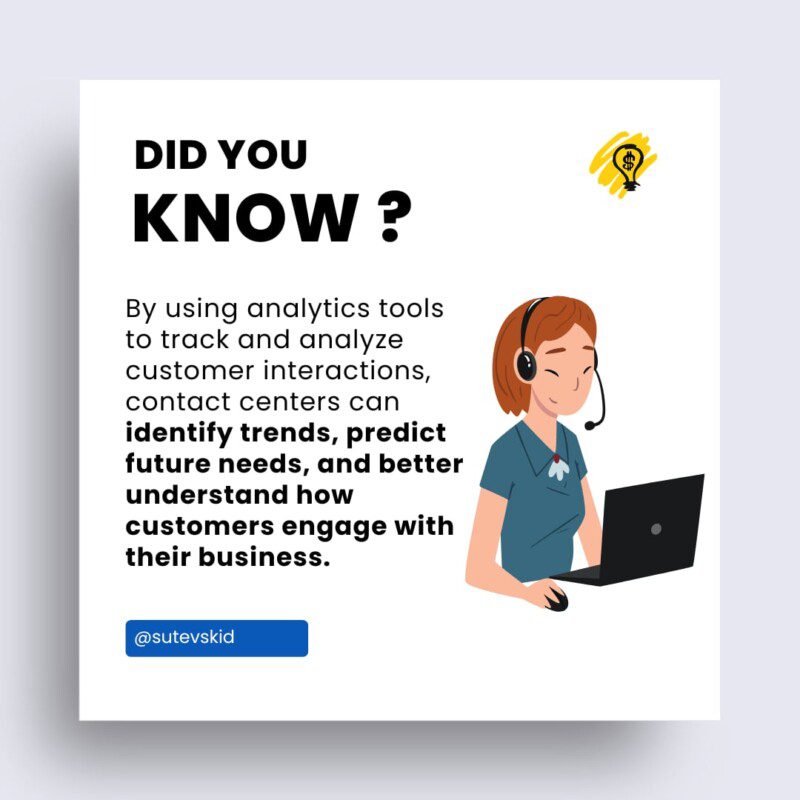The contact center is a hub of communication between customers and businesses. It is where customers reach out to resolve issues, seek answers, and share feedback. In the past, the contact center has been a reactive function that focuses on handling customer issues after they arise. However, modern businesses are shifting from reactive to proactive models that focus on anticipating customer needs.
One of the key strategies for this shift is harnessing the power of contact center analytics. Contact center analytics involves analyzing contact center data to uncover hidden insights and make data-driven decisions. By leveraging this data, businesses can gain a deeper understanding of customer behavior, preferences, and pain points.
In turn, they can proactively anticipate customer needs and address them before they become issues. This shift towards proactive customer service not only enhances customer satisfaction but also can lead to increased revenue and growth for businesses.
Make Data-Driven Decisions
It begins with identifying the key metrics that matter most for your specific business, such as average handle time, first call resolution rate, customer satisfaction score, and so on. Once you have these metrics in place, you can start to collect and analyze data to gain insights into how and why they may be fluctuating. These insights can then be used to make informed decisions about everything from staffing and training to process improvements and customer experience initiatives.
By leveraging data in this way, contact center leaders can anticipate customer needs, optimize performance, and stay several steps ahead of potential issues, ultimately elevating the overall customer experience.
Identify Opportunities for Improvement
By leveraging advanced contact center analytics, organizations can gain valuable insights into their customers’ behavior and preferences, allowing them to anticipate future needs and prevent potential issues. This proactive approach not only enhances the customer experience but also boosts operational efficiency and reduces costs.
To identify these opportunities, it is important to analyze customer feedback, track call volume trends, and monitor agent performance metrics. Organizations can then use this data to make informed decisions and implement targeted improvements that address customer pain points, increase customer satisfaction, and ultimately drive business success.
Create Automated Insights
Creating automated insights is a crucial step toward harnessing contact center analytics to anticipate customer needs. By leveraging data and machine learning algorithms, businesses can automate the process of generating insights that help them take proactive measures to improve customer experience. These insights include real-time monitoring of customer interactions, sentiment analysis, and identifying patterns in customer behavior.
Automated insights help businesses quickly identify issues or opportunities that require immediate attention, enabling them to take a proactive approach to customer service rather than reacting to problems after they occur. It also allows businesses to personalize their services and target their promotions and sales pitches to the specific needs and preferences of their customers.
Adapt to Changing Business Requirements
Contact center analytics can provide valuable insights into customer behavior, preferences, and patterns, which can help contact centers stay ahead of the curve and prevent potential issues. By using analytics tools to track and analyze customer interactions, contact centers can identify trends, predict future needs, and better understand how customers engage with their business. Ultimately, this allows contact centers to adapt to changing business requirements in real-time, providing more personalized and effective customer service.

Leverage Predictive Analytics for Forecasting
Leveraging predictive analytics is a crucial step in transitioning from a reactive to a proactive contact center. By utilizing advanced statistical algorithms and machine learning techniques, contact centers can make predictions about future customer behaviors and needs. This allows businesses to anticipate demand trends and adjust their operations accordingly, which can yield significant benefits such as reduced wait times, lower abandonment rates, and increased customer satisfaction.
Additionally, predictive analytics can aid in workforce management by predicting call volume and staffing needs and identifying areas of improvement in agent performance.
Utilize Machine Learning to Identify Trends and Patterns
Machine learning algorithms can analyze large volumes of data to identify common behaviors, preferences, and trends that can be used to predict future customer needs. By analyzing data from multiple channels, such as phone calls, chats, and social media interactions, customer service teams can identify patterns and trends that can help them anticipate customer needs before they even arise. This enables them to proactively offer personalized solutions that meet individual customer needs, leading to higher customer satisfaction and loyalty.
With advances in technology, including natural language processing and sentiment analysis, contact centers can now gain deeper insights into customer behavior and preferences, allowing them to tailor their offerings and services to meet the unique needs of each customer.
Implement Self-Service Solutions
These solutions allow customers to resolve their own issues without the need for human interaction, freeing up agents to focus on more complex customer concerns. Self-service options can include frequently asked questions (FAQs), online tutorials, automated chatbots, and mobile apps. By providing customers with access to these resources, contact centers can reduce call volume, decrease wait times, and improve overall customer satisfaction.
In addition, self-service analytics can be used to gain insights into customer behavior, identify recurring issues, and optimize knowledge bases to increase the effectiveness of these solutions. Implementing self-service solutions not only benefits customers but also streamlines operations for contact centers, making it a key component in a proactive customer experience strategy.
Monitor Performance Metrics in Real-Time
In order to proactively anticipate customer needs, it is essential to monitor performance metrics in real-time. The ability to track and analyze key measures such as average handle time, first call resolution, and customer satisfaction can enable contact centers to identify trends and issues before they become major problems. Contact center analytics tools offer real-time monitoring and alerting capabilities that can help managers stay on top of issues as they occur.
By utilizing these tools, contact centers can respond quickly to customer needs and ensure that quality service is being delivered consistently. With the ability to track performance metrics in real-time, contact centers can shift from a reactive approach to a proactive one, enabling them to provide the best possible customer experience.
Conclusion
Implementing advanced analytics and predictive models can help contact centers transform from being reactive to proactive. By analyzing customer data, contact centers can anticipate customer needs, identify potential issues, and take action to improve the customer experience. This can lead to increased customer satisfaction, loyalty, and retention, as well as drive bottom-line business results. It’s time for contact center leaders to harness the power of analytics and take their customer service to the next level.





